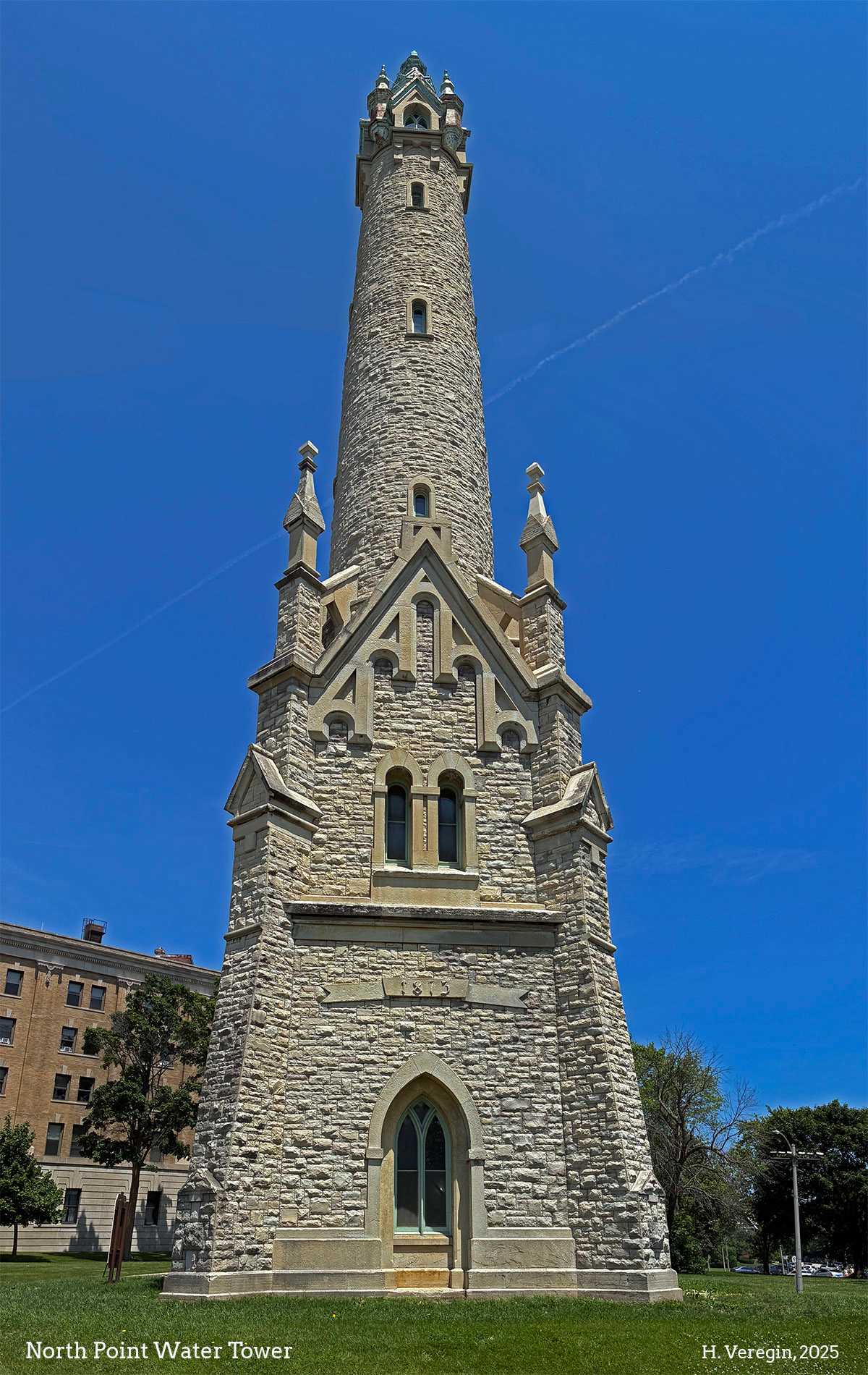Nineteenth-century water towers still stand in several Wisconsin communities, including Sun Prairie [1], Clinton [2], Beloit [3], Benton [4], Monroe [5] and Burlington [6], to name a few. These towers were built to supply the water needs of growing communities, including fire-fighting, steam locomotives and residential and commercial uses.
These towers typically consisted of a large, elevated tank containing thousands of gallons of water. Water was pumped into the tank from a nearby source, such as a lake. Hydrostatic pressure due to the force of gravity then enabled the water to be distributed through water mains. The basic idea hasn’t changed much over the years. Modern spheroidal (slightly flattened sphere) water towers, which can hold several million gallons, dot Wisconsin’s landscape, resembling giant lollipops. [7]
Milwaukee’s North Point Water Tower, built in 1873, is different. That’s because there’s no water tank inside. Instead, the tower houses a standpipe 4 feet in diameter by 120 feet high. A pipe with those dimensions can hold about 14,000 gallons, but the main purpose of the pipe was not to store water, but to prevent water hammer from destroying the water main system.
Water hammer is the shockwave that occurs when the kinetic energy of water is converted to potential energy. If water in a pipe encounters resistance – for example, from an obstruction or from water already in the pipe – pressure waves travel back and forth between the resistance point and the source. The wave increases water pressure in the pipe, which can cause it to rupture. A standpipe is an open vent in the pipe, designed to relieve overpressure so that damage does not occur. [8]
When North Point Water Tower was built, water was supplied from Lake Michigan. North Point Pumping Station, on the lakeshore at the foot of East North Ave., used steam engines to pump lake water uphill to the Kilbourn Park Reservoir, located a mile to the west. The reservoir was about 100 feet higher than the lake. The standpipe in North Point Water Tower relieved the pulsations caused by the steam engines, minimizing the danger of water hammer. [9]
North Point Pumping Station should not be confused with the old River Flushing Tunnel Station, at the corner of North Lincoln Memorial Dr. and East Lafayette Hill Rd. The Flushing Station, now a popular coffee shop, was built in 1888 to flush stagnant water from the Milwaukee River. [10] While the Flushing Station building survives, North Point Pumping Station was demolished in the 1960s and replaced by a modern facility with electric pumps. [11]
Similar standpipe systems were built in the nineteenth century in other US cities. The first known installation was in Germantown, Pennsylvania, in 1851. [12] The city of Chicago’s water tower, built in 1869, survived the 1871 Chicago Fire and still stands on Michigan Ave., next to Water Tower Place. Madison had a standpipe water tower on East Washington Ave., but it was torn down in 1921 because it marred views of the Capitol. [13]
North Point Water Tower was taken out of service in the 1960s when the new electrical pumps were installed in North Point Pumping Station. These pumps operated smoothly, and water pressure surges were no longer a problem. Fortunately, unlike the pumping station, the tower was preserved and designated as a local landmark in 1968. It is also listed in the National Register of Historic Places. [14]
The tower is a unique example of Victorian Gothic design. It has a lower base with buttresses, a tapering cylindrical shaft and an observation platform at the top, at a height of 175 feet. [14] The observation platform is not open to the public. Inside the tower, the riveted metal standpipe is surrounded by a circular staircase, with 213 steps in total. [15]
But why the elaborate stone tower? Would a metal standpipe sticking into the sky not do the job? One reason is aesthetics. Like the North Point Pumping Station, the tower was an expression of civic pride, and its ornate design reflected a desire for beauty in the urban landscape.
The other reason is more practical – Wisconsin’s cold winter climate. The stone tower helped keep the water in the standpipe from freezing, which would have compromised its pressure-relieving capabilities.
Sources
[1] Sun Prairie Water Tower, Clio. https://theclio.com/entry/150150
[2] The Old Clinton Water Tower, Historical Marker Database. https://www.hmdb.org/m.asp?m=133537
[3] Beloit Water Tower, Wisconsin Historical Society. https://www.wisconsinhistory.org/Records/Property/HI16570
[4] Benton Stone Water Tower, Wisconsin Historical Society. https://www.wisconsinhistory.org/Records/NationalRegister/NR2281
[5] Monroe Water Tower, Wisconsin Historical Society. https://www.wisconsinhistory.org/Records/NationalRegister/NR2067
[6] Burlington Water Tower, Wisconsin Historical Society. https://www.wisconsinhistory.org/Records/Image/IM84531
[7] AnnMarie Hilton, Everything you need to know about Wisconsin's water towers: The good, the 'evil,' and the people who swim in your drinking water, Sheboygan Press, March 8, 2021. https://www.sheboyganpress.com/story/news/2021/03/08/wisconsin-water-towers-their-stories-and-what-they-do-besides-hold-water/4203820001/
[8] Water Hammer (Waterhammer) Review and Equation, Engineers Edge. https://www.engineersedge.com/fluid_flow/water_hammer.htm
[9] Historic Designation Study Report North Point Water Tower, City of Milwaukee, 1982. https://city.milwaukee.gov/ImageLibrary/Groups/cityHPC/DesignatedReports/vticnf/NorthPointWaterTower.pdf
[10] Bobby Tanzilo, Urban Spelunking: Colectivo Lakefront Cafe / Milwaukee River Flushing Station, OnMilwaukee, May 2, 2017. https://onmilwaukee.com/articles/urban-spelunking-colectivo-lakefront
[11] The North Point Pumping Station, City of Milwaukee. https://city.milwaukee.gov/water/History-Fun-Stuff/NorthPoint-Pumping-Station
[12] Documentary History of American Water-works, Water Works History. http://www.waterworkshistory.us/tech/standpipes.htm
[13] Capitol View of the Water Tower, Wisconsin Historical Society. https://www.wisconsinhistory.org/Records/Image/IM3507
[14] North Point Water Tower, National Register of Historic Places. https://catalog.archives.gov/id/106781751
[15] The North Point Water Tower, Milwaukee Water Works. https://city.milwaukee.gov/water/about/North-Point-Tower
